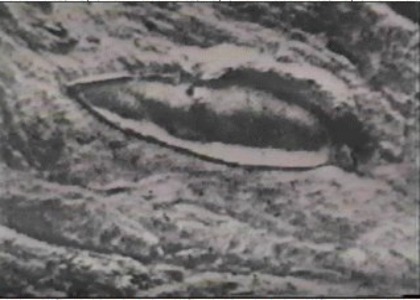KEEP WATCH
Ancient Discoveries on Trial
Part 3: Did Ron Wyatt find Noah's Ark?
Jim Allen

Page One
"Ron Wyatt has, through his book and video, created an interest among lay members in this boat-shaped site. Wyatt claims that the Turkish government credits him with finding the Durupinar site, and thus, the discoverer of Noah's Ark.... This is an unusual claim since this site was discovered in 1959...and even acknowledged, if somewhat lightly, by Wyatt himself..." [3.5] The Turkish government credited the discovery and named the site after Captain Llhan Durupinar.
Was Wyatt given credit for finding Noah's ark? Yes, according to Wyatt Archaeological Research. In fact, the Turkish Government attributed the "official" finding of Noah's Ark to Wyatt, on June 20, 1987. Wyatt was the guest of honor at the official dedication of the site. As you might imagine, archeologists who later learned about Wyatt's notoriety and the dedication of the site in his honor (as the official site of Noah's Ark) were less than pleased.
"Ron Wyatt is neither an archaeologist nor has he ever carried out a legally licensed excavation in Israel or Jerusalem. In order to excavate one must have at least a BA in archaeology which he does not possess despite his claims to the contrary..." [3.6] It would appear Wyatt persuaded the Turkish officials that the Durupınar site was indeed the actual ark using evidence from the ark site he provided as proof. Unfortunately, the evidence was never recognized by the archeological community as verifiable evidence. In other words, Wyatt's excavation efforts of the Durupınar site did not follow scientific excavation, preparation and run-through to properly analyze and verify the artifacts as genuine.
"There are several negative things about Wyatt's efforts on the site which do nothing to help but hinder it, foremost of which was his attempt to fabricate rib-evidence on one side of the Ark-mold structure. His other claims of 'petrified wood and animal hair' are unsubstantiated. The Ark however, was not his discovery, but to his credit he did find the Ark's anchor stones at Kazan." [3.7]
Because of the shoddy presentation of evidence and ongoing debunking of the Durupınar site by professionals and creationists, the visitor center at the site has fallen into disrepair. While the visitor center is still open to the public, interest in the site and its artifacts continue to fade like the setting sun. Of additional interest, "Ron Wyatt's side-kick on his Durupinar expedition was David Fasold. Toward the end of Fasold's life he co-authored an article with Lorence Collins that was published in a peer-reviewed scientific publication called the Journal of Geoscience Education ..." The article rebuked Wyatt's discovery as bogus and agreed with Baumgardner's conclusion that the geological formation cannot be the remains of Noah's ark." [3.8]
Amidst scientific and religious push-back on the excavated evidence, there are some who maintain Wyatt really did find Noah's Ark. Though the scientific community and creationists seldom agree on anything, they agree in this instance and denounce the Durupınar site as nothing more than soil and rock irregularities molded by natural causes. If you look closely around the site - in the many online photographs of the site - you will see other nearby protruding soil and rock formations similar to that of the alleged ark site.
As for the undecided, Noah' Ark did exist. It served its holy purpose thousands of years ago. Some say the vessel is buried, unbroken, under a glacier near a mountain peak. Others say the ark is torn apart and strewn under glacial ice. But even if the ark could be found or the ark site at Durupınar proven true, its discovery would do little to convert anyone to faith in Christ (Romans 10:17).
Noah's Ark is an ancient footnote in bible history and a notable vessel in its time. Even though the mission of the ark is now long complete, it continues to echo a message of great truth through the halls of time. Noah's Ark is an enduring picture of salvation. The ark, broken or whole, or wherever it may be is a picture of the living Christ who was broken for us (1 Corinthians 11:24) to make us whole again (Colossians 2:10).
If you've entered into this ark you will know it to be true (Romans 8:16). If you are unsure, there is still time to find the doorway to the living Ark (John 3:1-7). To enter will be the greatest discovery of a lifetime and the Treasure of all treasures to possess for eternity (Matthew 6:19-21).
3.5 Andrews University — Institute of Archaeology — "Has Noah's Ark been found?" — David Merling, Ph.D.
3.6 "Letter from Joe Zias"
3.7 "Naxuan, The Lost City of Noah Found!"
3.8 Life and Land seminars — "Noah's Ark is (still) in Turkey"
Ancient Discoveries on Trial: The Series
Part 1: Are the ancient discoveries by Ron Wyatt true or religious fraud?Part 2: Did Ron Wyatt find the Ark of the Covenant?
Part 3: Did Ron Wyatt find Noah's Ark?
Part 4: Did Ron Wyatt find the Red Sea crossing? — Coming Soon
Tags: Controversial-Issues | History-Apologetics
comments powered by Disqus
Published 2-5-14

